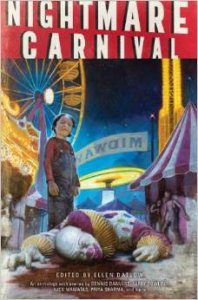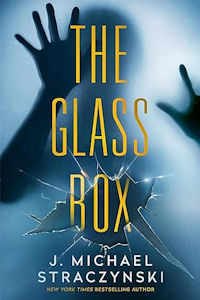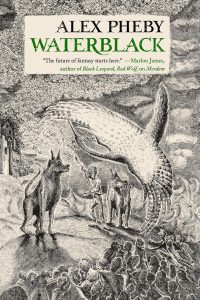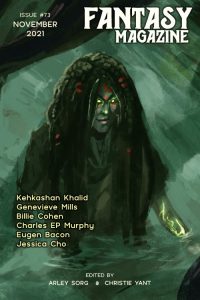Stefan Dziemianowicz reviews Ellen Datlow’s Nightmare Carnival
Nightmare Carnival, Ellen Datlow, ed. (Dark Horse Books 978-1-61655-427-9, $19.99, 384pp, tp) October 2014.
 For her anthology Nightmare Carnival, Ellen Datlow has assembled 15 new stories that explore the horrific possibilities inherent in carnivals and their entertainments. The dark carnival theme has been a staple of weird fiction since the early part of the twentieth century, and over the decades numerous writers have written stories drawn from its most familiar inspirations, notably sideshow performers whose incredible feats border on the uncanny, and the grotesque physical horrors of the freak show. Several of the stories in Nightmare Carnival fit this bill, but to Datlow’s credit a number of her selections take the dark carnival theme into provocative new territory.
For her anthology Nightmare Carnival, Ellen Datlow has assembled 15 new stories that explore the horrific possibilities inherent in carnivals and their entertainments. The dark carnival theme has been a staple of weird fiction since the early part of the twentieth century, and over the decades numerous writers have written stories drawn from its most familiar inspirations, notably sideshow performers whose incredible feats border on the uncanny, and the grotesque physical horrors of the freak show. Several of the stories in Nightmare Carnival fit this bill, but to Datlow’s credit a number of her selections take the dark carnival theme into provocative new territory.
Among the book’s more traditional tales are N. Lee Wood’s ‘‘Scapegoats’’, which fictionalizes an actual historical incident that occurred in Erwin TN in 1916, when angry townspeople compelled the grisly execution by hanging of a traveling carnival elephant who had the day before killed one of her handlers. The most horrifying aspect of the story is the cruelty of the townspeople, who see the spectacle of the elephant’s death as just another form of entertainment. Wood grafts a twist ending onto her tale that will put readers in mind of Tod Browning’s cult film Freaks, whose source material – Tod Robbins’s pulp story ‘‘Spurs’’ – was possibly the very first dark carnival story. The lynch mob spirit pervasive in Wood’s story also permeates Nick Mamatas’s ‘‘Work, Hook, Shoot, Rip’’, a period tale that leavens its grim depiction of racial bigotry in early twentieth century America with ironic reflections on the artifice of carnival entertainments and the treatment of sideshow exotics as outsiders to normal human society.
It’s a given in most dark carnival stories that, at some point, entertainments that seem inexplicably fantastic are revealed to be genuinely so. In Jeffrey Ford’s ‘‘Hibbler’s Minions’’, a second-rate carnival runs full tilt into the supernatural when its virtuoso flea-circus performers, who have been harvested from the corpse of a sideshow monstrosity, prove to be formidable monsters in their own right. The heroine in Priya Sharma’s ‘‘The Firebrand’’ presents her formidable fire-wielding talents as just a well-staged act, until her troubled relationship with two other carnival employees forces her to reveal their true nature. Similarly, the singing acrobat in Dennis Danvers’s ‘‘Swan Song and Then Some’’ – whose nightly act involves swan-diving to her death and then resurrecting herself – proves to have a much more profound explanation for her talents than the incantatory power of her song. For readers who prefer their carnivals unabashedly weird behind the guise of glitzy entertainment, there’s A.C. Wise’s ‘‘And the Carnival Leaves Town’’, about a traveling sideshow that leaves a legacy of death and disappearance in each town it passes through, and Terry Dowling’s wonderfully unconventional ‘‘Corpse Rose’’, in which a traveling carnival’s offbeat attractions prove to be encoded with malignant meaning that determine the type mayhem the carnival will secretly wreak upon the world.
Two of the book’s selections are sequels or sidebars to earlier stories by their authors. Glen Hirshberg’s ‘‘A Small Part in the Pantomime’’ is a follow-up to ‘‘Mr. Dark’s Carnival’’, his World Fantasy Award-nominated story from 2000 about a carnival of the dead that manifests on Halloween and snares a university professor studying its lore and legendry. The new story recapitulates the events of its predecessor, with academic colleagues drawing a newly tenured professor into the same web of eerie incidents that overwhelmed the protagonist of the earlier tale. In Laird Barron’s ‘‘Screaming Elk, MT’’, the heroine of his 2013 story, ‘‘Termination Dust’’, who survived an attack by a supernaturally empowered serial killer, plays a crucial role in ending a curse that has dogged a traveling carnival for half a century. Barron’s protagonist, Jessica Mace, is a wonderfully feisty fighter with a badass streak, who can easily hold her own with any of the tale’s macho male characters. She’d make a great series character in future stories.
A handful of stories in Nightmare Carnival approach their carnival props more obliquely, to evoke the carnival midway’s spirit of strangeness. In Genevieve Valentine’s ‘‘The Lion Cage’’, the reason for the narrator’s strong aversion to a carnival’s pair of caged lions lies tantalizingly just beyond explanation, and this intensifies the menace and mystery of the tale’s events. Likewise with Stephen Graham Jones’s ‘‘The Darkest Part’’, the characters’ obsessive interest in killing a carnival clown (something that will resonate with any reader who remembers being terrified of clowns as a kid) cripples them with haunting visions and memories after the act. Robert Shearman’s ‘‘The Popping Fields’’ is a poignant meditation on life and art that juxtaposes the pregnancy of the daughter of a carnival-following balloon artist with the nightly parade of malformed balloon animals who come to him to be euthanized.
And then there’s Nathan Ballingrud’s ‘‘Skullpocket’’, the story in Nightmare Carnival that reads the most noticeably as an homage to the fiction of Ray Bradbury, the leading exponent of the dark carnival tale. In his novel Something Wicked This Way Comes, the wraparound story for his collection The Illustrated Man, several stories in his short-fiction first collection – the aptly named Dark Carnival – and elsewhere, Bradbury used the monsters of the midway as mirrors for reflecting the dark side of the human condition. ‘‘Skullpocket’’ will put readers in mind of these tales, as well as Bradbury’s tales of the Elliott family, fixed up as his novel From the Dust Returned: supernatural outsiders who live on the fringe of human society and who number among themselves witches, werewolves, vampires, and the occasional misbegotten mortal. For his tale, Ballingrud has created a fully realized culture of ghouls who haunt the cemetery of a seaside everyville named Hob’s Landing. They go by names such as Wormcake, Slipwicket, and Stubblegut, and they all worship at the Church of the Maggot and participate in rites and rituals particular to ghoul culture. The event at the center of the story is the Seventieth Annual Skullpocket Fair – ‘‘skullpocket’’ refers to a game played by the young that might best be described as an extreme ghoul version of kick-the-can – to which a select audience of human children are invited and told how and why the fair came into being.
The ghoul point of view of Ballingrud’s tale is marvelously inverted. Events are recounted predominantly from the viewpoint of Jonathan Wormcake, one of three mischievous young ghouls who, a century before, disobeyed their parents and left the confines of their cemetery to venture into human society. The trio goes unrecognized because, to humans, they look simply like ‘‘sickly children, afflicted with some mysterious wasting illness that blued their flesh and tightened the skin around their bones.’’ The ghouls, on the other hand, are horrified at the pageant of the living that they see at a carnival whose grounds they’ve intruded upon: they are used to seeing ‘‘humans in repose, quiet little morsels in their thin little boxes.’’ This is all part of the story being told to the children at the Skullpocket Fair, and just when it seems that Ballingrud’s tale will end as a child’s history of human/ghoul social assimilation, it takes a startling turn into the darker territory that its events have paved the way for. Like the story told to the children, ‘‘Skullpocket’’ proves, in the words of one of its characters, a type of ‘‘mythmaking’’ designed to make palatable the gruesome realities of death and dissolution that are the hallmarks of human mortality. Ballingrud’s tale is a magnificent piece of storytelling. Accompanied by another 14 estimable acts, it makes admission into Nightmare Carnival well worth the price.






